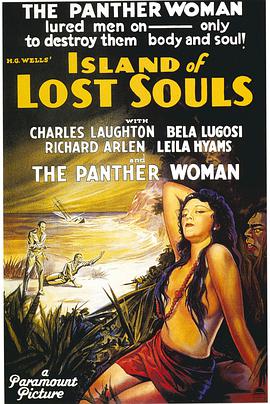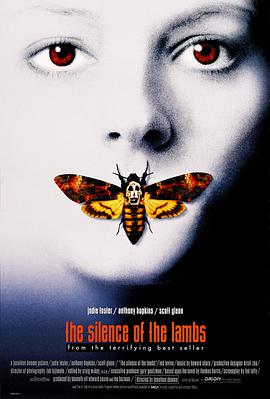年份:1932 类型:科幻片
主演:查尔斯·劳顿,理查德·阿伦,丽拉·海厄姆斯,贝拉·卢戈西,凯斯琳·伯克,亚瑟·霍尔,斯坦利·菲尔茨,保罗·赫斯特,汉斯·施泰因克,TetsuKomai,乔治·欧文
导演:厄尔·C·肯顿
地区:美国
语言:英语
剧情简介
这部电影是根据威尔斯的小说改编的。讲述了一位科学家在岛上进行人兽杂交实验,试图创造出伟大超人的故事。但一次次的失败却产生了一个可怕的结果:大量的畸形人。他们被奴役和虐待。一艘沉船把一群英国人带到了岛上,科学家试图让一名豹女与一名客人交配。最后,畸形人反目成仇,推翻了邪恶科学家。
A double-bill of pre-code horror adaptations of H.G. Wells’ novels, both have a mad scientist going to extremes in their purported scientific experiments, in Erle C. Kenton’s ISLANDS OF LOST SOULS, Dr. Moreau (Laughton) is secluded on an off-the-map South Pacific island, carrying out beast-human chimera horrors (to what purpose? we are not 100 percent sure), whereas in James Whale’s THE INVISIBLE MAN, Dr. Jack Griffin (Rains) inflicts on himself the burden of invisibility (the film is set in a wintry Sussex, running stark naked is certainly not a pleasurable activity), and tries to conquer the world with “reign of terrors”? Yes, he is irrefragably mad.
Two mad men, one unwisely invites an outsider into his inner sanctum, which inevitably will bring doom to his unethical creations, Dr. Moreau’s monomania is to posit himself on the pedestal as a “God”, founding his own Creationism, by tampering with the natural process of evolution; another, driven by his infeasible and camp ambition, is a forlorn hope by acting as a lone wolf, against the mass’ collective endeavor to cop him at any cost, Dr. Griffin’s undoings are his poisoned cravings for power and cruelty (at one point, Rains’ gestures even imitate Mussolini’s), Both films faithfully convey Wells’ alertness and condemnation of “übermensch”, and if their plots are conventional to a fault, those two oldies are robust for their atmospheric constructions.
In ISLANDS…,, although the fog-wreathed island makes for a striking presence, it is the ghastly-looking maquillages and prosthetics applied to those “strange-looking natives” elicit our primordial abhorrence (with Bela Lugosi hidden underneath a hirsute mask), or in the case of the panther woman Lota (a doe-eyed Burke, exploited for her exotic looks), our fixation and some befuddlement (one may gripe that the animality of the mutated herd is underrepresented here). However, Kenton’s overall execution is more perfunctory than satisfactory, leaving much of the contentious arguments to be desired.
Whale’s THE INVISIBLE MAN, contrarily, ages much better, foremost, owing to its cutting-edge, deceptive matte effect to reify the alchemical transmutation of Dr. Griffin’s bandages-unfurling invisibility, and the end result is still stunning to behold. While ISLANDS… cannot blot out the unsavory whiff of white man’s burden and slavery (a loyal servant is played by the oriental Tetsu Komai, naturally with canine genes), THE INVISIBLE MAN has more thrills and spills for viewers to bask in, be it when Griffin makes the fur fly in the village where he unwisely chooses to lie low, with a scene-stealing Una O’Connor squealing and quibbling like nobody’s business, or his sinister turn with Dr. Arthur Kemp (Harrigan, perfectly cast as a craven ordinary Joe), whose demise adds a layer of wantonness onto the mania-at-large, whereas Gloria Stewart, who plays Griffin’s fiancée, is considerately kept out of harm’s way.
It is no wonder that two eloquent British thespians are headlining the two pictures, a young, whip-thrashing Laughton is both crafty and incredibly naive as Dr. Moreau, but never boring, even Dr. Moreau’s actions are nigh on irrationally; Rains, in his very first American picture, whose face is entirely (save for the final scene) swathed in bandages, still cows (almost) everyone into submission with his threatening locution alone (for sure, his short stature can of little avail in this case), a pitiful villain only rues the day in his last gasp.
referential entries: Merian C. Cooper and Ernest B. Schoedsack’s KING KONG (1933, 7.8/10); Whale’s THE OLD DARK HOUSE (1932, 6,7/10); Leigh Whannell’s THE INVISIBLE MAN (2020, 6.9/10).
{if:"
A double-bill of pre-code horror adaptations of H.G. Wells’ novels, both have a mad scientist going to extremes in their purported scientific experiments, in Erle C. Kenton’s ISLANDS OF LOST SOULS, Dr. Moreau (Laughton) is secluded on an off-the-map South Pacific island, carrying out beast-human chimera horrors (to what purpose? we are not 100 percent sure), whereas in James Whale’s THE INVISIBLE MAN, Dr. Jack Griffin (Rains) inflicts on himself the burden of invisibility (the film is set in a wintry Sussex, running stark naked is certainly not a pleasurable activity), and tries to conquer the world with “reign of terrors”? Yes, he is irrefragably mad.
Two mad men, one unwisely invites an outsider into his inner sanctum, which inevitably will bring doom to his unethical creations, Dr. Moreau’s monomania is to posit himself on the pedestal as a “God”, founding his own Creationism, by tampering with the natural process of evolution; another, driven by his infeasible and camp ambition, is a forlorn hope by acting as a lone wolf, against the mass’ collective endeavor to cop him at any cost, Dr. Griffin’s undoings are his poisoned cravings for power and cruelty (at one point, Rains’ gestures even imitate Mussolini’s), Both films faithfully convey Wells’ alertness and condemnation of “übermensch”, and if their plots are conventional to a fault, those two oldies are robust for their atmospheric constructions.
In ISLANDS…,, although the fog-wreathed island makes for a striking presence, it is the ghastly-looking maquillages and prosthetics applied to those “strange-looking natives” elicit our primordial abhorrence (with Bela Lugosi hidden underneath a hirsute mask), or in the case of the panther woman Lota (a doe-eyed Burke, exploited for her exotic looks), our fixation and some befuddlement (one may gripe that the animality of the mutated herd is underrepresented here). However, Kenton’s overall execution is more perfunctory than satisfactory, leaving much of the contentious arguments to be desired.
Whale’s THE INVISIBLE MAN, contrarily, ages much better, foremost, owing to its cutting-edge, deceptive matte effect to reify the alchemical transmutation of Dr. Griffin’s bandages-unfurling invisibility, and the end result is still stunning to behold. While ISLANDS… cannot blot out the unsavory whiff of white man’s burden and slavery (a loyal servant is played by the oriental Tetsu Komai, naturally with canine genes), THE INVISIBLE MAN has more thrills and spills for viewers to bask in, be it when Griffin makes the fur fly in the village where he unwisely chooses to lie low, with a scene-stealing Una O’Connor squealing and quibbling like nobody’s business, or his sinister turn with Dr. Arthur Kemp (Harrigan, perfectly cast as a craven ordinary Joe), whose demise adds a layer of wantonness onto the mania-at-large, whereas Gloria Stewart, who plays Griffin’s fiancée, is considerately kept out of harm’s way.
It is no wonder that two eloquent British thespians are headlining the two pictures, a young, whip-thrashing Laughton is both crafty and incredibly naive as Dr. Moreau, but never boring, even Dr. Moreau’s actions are nigh on irrationally; Rains, in his very first American picture, whose face is entirely (save for the final scene) swathed in bandages, still cows (almost) everyone into submission with his threatening locution alone (for sure, his short stature can of little avail in this case), a pitiful villain only rues the day in his last gasp.
referential entries: Merian C. Cooper and Ernest B. Schoedsack’s KING KONG (1933, 7.8/10); Whale’s THE OLD DARK HOUSE (1932, 6,7/10); Leigh Whannell’s THE INVISIBLE MAN (2020, 6.9/10).
"<>"" && "
A double-bill of pre-code horror adaptations of H.G. Wells’ novels, both have a mad scientist going to extremes in their purported scientific experiments, in Erle C. Kenton’s ISLANDS OF LOST SOULS, Dr. Moreau (Laughton) is secluded on an off-the-map South Pacific island, carrying out beast-human chimera horrors (to what purpose? we are not 100 percent sure), whereas in James Whale’s THE INVISIBLE MAN, Dr. Jack Griffin (Rains) inflicts on himself the burden of invisibility (the film is set in a wintry Sussex, running stark naked is certainly not a pleasurable activity), and tries to conquer the world with “reign of terrors”? Yes, he is irrefragably mad.
Two mad men, one unwisely invites an outsider into his inner sanctum, which inevitably will bring doom to his unethical creations, Dr. Moreau’s monomania is to posit himself on the pedestal as a “God”, founding his own Creationism, by tampering with the natural process of evolution; another, driven by his infeasible and camp ambition, is a forlorn hope by acting as a lone wolf, against the mass’ collective endeavor to cop him at any cost, Dr. Griffin’s undoings are his poisoned cravings for power and cruelty (at one point, Rains’ gestures even imitate Mussolini’s), Both films faithfully convey Wells’ alertness and condemnation of “übermensch”, and if their plots are conventional to a fault, those two oldies are robust for their atmospheric constructions.
In ISLANDS…,, although the fog-wreathed island makes for a striking presence, it is the ghastly-looking maquillages and prosthetics applied to those “strange-looking natives” elicit our primordial abhorrence (with Bela Lugosi hidden underneath a hirsute mask), or in the case of the panther woman Lota (a doe-eyed Burke, exploited for her exotic looks), our fixation and some befuddlement (one may gripe that the animality of the mutated herd is underrepresented here). However, Kenton’s overall execution is more perfunctory than satisfactory, leaving much of the contentious arguments to be desired.
Whale’s THE INVISIBLE MAN, contrarily, ages much better, foremost, owing to its cutting-edge, deceptive matte effect to reify the alchemical transmutation of Dr. Griffin’s bandages-unfurling invisibility, and the end result is still stunning to behold. While ISLANDS… cannot blot out the unsavory whiff of white man’s burden and slavery (a loyal servant is played by the oriental Tetsu Komai, naturally with canine genes), THE INVISIBLE MAN has more thrills and spills for viewers to bask in, be it when Griffin makes the fur fly in the village where he unwisely chooses to lie low, with a scene-stealing Una O’Connor squealing and quibbling like nobody’s business, or his sinister turn with Dr. Arthur Kemp (Harrigan, perfectly cast as a craven ordinary Joe), whose demise adds a layer of wantonness onto the mania-at-large, whereas Gloria Stewart, who plays Griffin’s fiancée, is considerately kept out of harm’s way.
It is no wonder that two eloquent British thespians are headlining the two pictures, a young, whip-thrashing Laughton is both crafty and incredibly naive as Dr. Moreau, but never boring, even Dr. Moreau’s actions are nigh on irrationally; Rains, in his very first American picture, whose face is entirely (save for the final scene) swathed in bandages, still cows (almost) everyone into submission with his threatening locution alone (for sure, his short stature can of little avail in this case), a pitiful villain only rues the day in his last gasp.
referential entries: Merian C. Cooper and Ernest B. Schoedsack’s KING KONG (1933, 7.8/10); Whale’s THE OLD DARK HOUSE (1932, 6,7/10); Leigh Whannell’s THE INVISIBLE MAN (2020, 6.9/10).
"<>"暂时没有网友评论该影片"}
{end if}










亡魂岛影评
A double-bill of pre-code horror adaptations of H.G. Wells’ novels, both have a mad scientist going to extremes in their purported scientific experiments, in Erle C. Kenton’s ISLANDS OF LOST SOULS, Dr. Moreau (Laughton) is secluded on an off-the-map South Pacific island, carrying out beast-human chimera horrors (to what purpose? we are not 100 percent sure), whereas in James Whale’s THE INVISIBLE MAN, Dr. Jack Griffin (Rains) inflicts on himself the burden of invisibility (the film is set in a wintry Sussex, running stark naked is certainly not a pleasurable activity), and tries to conquer the world with “reign of terrors”? Yes, he is irrefragably mad.
Two mad men, one unwisely invites an outsider into his inner sanctum, which inevitably will bring doom to his unethical creations, Dr. Moreau’s monomania is to posit himself on the pedestal as a “God”, founding his own Creationism, by tampering with the natural process of evolution; another, driven by his infeasible and camp ambition, is a forlorn hope by acting as a lone wolf, against the mass’ collective endeavor to cop him at any cost, Dr. Griffin’s undoings are his poisoned cravings for power and cruelty (at one point, Rains’ gestures even imitate Mussolini’s), Both films faithfully convey Wells’ alertness and condemnation of “übermensch”, and if their plots are conventional to a fault, those two oldies are robust for their atmospheric constructions.
In ISLANDS…,, although the fog-wreathed island makes for a striking presence, it is the ghastly-looking maquillages and prosthetics applied to those “strange-looking natives” elicit our primordial abhorrence (with Bela Lugosi hidden underneath a hirsute mask), or in the case of the panther woman Lota (a doe-eyed Burke, exploited for her exotic looks), our fixation and some befuddlement (one may gripe that the animality of the mutated herd is underrepresented here). However, Kenton’s overall execution is more perfunctory than satisfactory, leaving much of the contentious arguments to be desired.
Whale’s THE INVISIBLE MAN, contrarily, ages much better, foremost, owing to its cutting-edge, deceptive matte effect to reify the alchemical transmutation of Dr. Griffin’s bandages-unfurling invisibility, and the end result is still stunning to behold. While ISLANDS… cannot blot out the unsavory whiff of white man’s burden and slavery (a loyal servant is played by the oriental Tetsu Komai, naturally with canine genes), THE INVISIBLE MAN has more thrills and spills for viewers to bask in, be it when Griffin makes the fur fly in the village where he unwisely chooses to lie low, with a scene-stealing Una O’Connor squealing and quibbling like nobody’s business, or his sinister turn with Dr. Arthur Kemp (Harrigan, perfectly cast as a craven ordinary Joe), whose demise adds a layer of wantonness onto the mania-at-large, whereas Gloria Stewart, who plays Griffin’s fiancée, is considerately kept out of harm’s way.
It is no wonder that two eloquent British thespians are headlining the two pictures, a young, whip-thrashing Laughton is both crafty and incredibly naive as Dr. Moreau, but never boring, even Dr. Moreau’s actions are nigh on irrationally; Rains, in his very first American picture, whose face is entirely (save for the final scene) swathed in bandages, still cows (almost) everyone into submission with his threatening locution alone (for sure, his short stature can of little avail in this case), a pitiful villain only rues the day in his last gasp.
referential entries: Merian C. Cooper and Ernest B. Schoedsack’s KING KONG (1933, 7.8/10); Whale’s THE OLD DARK HOUSE (1932, 6,7/10); Leigh Whannell’s THE INVISIBLE MAN (2020, 6.9/10).